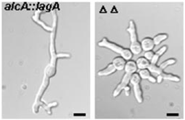Department of Chemistry
Date of this Version
2017
Citation
Zhang et al. BMC Biotechnology (2017) 17:59 DOI 10.1186/s12896-017-0377-y
Abstract
Background: The environmental gliding bacteria Lysobacter are emerging as a new group of biocontrol agents due to their prolific production of lytic enzymes and potent antibiotic natural products. These bacteria are intrinsically resistant to many antibiotics, but the mechanisms behind the antibiotic resistance have not been investigated.
Results: Previously, we have used chloramphenicol acetyltransferase gene (cat) as a selection marker in genetic manipulation of natural product biosynthetic genes in Lysobacter, because chloramphenicol is one of the two common antibiotics that Lysobacter are susceptible to. Here, we found L. enzymogenes, the most studied species of this genus, could still grow in the presence of a low concentration of chloramphenicol. Three chloramphenicol derivatives (1–3) with an unusual acylation pattern were identified in a cat-containing mutant of L. enzymogenes and in the wild type. The compounds included chloramphenicol 3'-isobutyrate (1), a new compound chloramphenicol 1'- isobutyrate (2), and a rare chloramphenicol 3'-isovalerate (3). Furthermore, a mutation of a global regulator gene (clp) or a Gcn5-related N-acetyltransferase (GNAT) gene in L. enzymogenes led to nearly no growth in media containing chloramphenicol, whereas a complementation of clp restored the chloramphenicol acylation as well as antibiotic HSAF production in the clp mutant.
Conclusions: The results indicated that L. enzymogenes contains a pool of unusual acyl donors for enzymatic modification of chloramphenicol that confers the resistance, which may involve the Clp-GNAT regulatory system. Because Lysobacter are ubiquitous inhabitants of soil and water, the finding may have important implications in understanding microbial competitions and bioactive natural product regulation.


Comments
© The Author(s). 2017 Open Access This article is distributed under the terms of the Creative Commons Attribution 4.0 International License